

Western Blotting. Western blot analysis can detect one protein in a mixture of any number of proteins while giving you information about the size of the protein. It does not matter whether the protein has been synthesized in vivo or in vitro. This method is, however, dependent on the use of a high-quality antibody directed against a desired protein.
So you must be able to produce at least a small portion of the protein from a cloned DNA fragment. You will use this antibody as a probe to detect the protein of interest. Western blotting tells you how much protein has accumulated in cells. Let's look at this technique in greater detail. 1. 2. One thing to be aware of is that proteins bind better to nitrocellulose at a low pH. 3. 4. 5. 6. Making a primary antibody This description assumes you have available purified protein. Carefully cut out the band and soak it in 1 mL PBS buffer. Rest the rabbit for one month, then repeat the process using an incomplete adjuvant. IL-4 Signaling and its Primary Biological Effects in Different Immune Cell Types. Overview of IL-4 Signaling and its Primary Biological Effects in Different Immune Cell Types Interleukin-4 (IL-4) is a glycosylated, type I cytokine with three intra-chain disulfide bridges that adopts a bundled four alpha-helix structure.
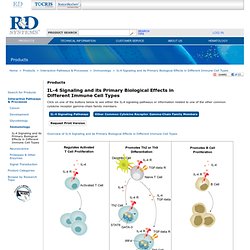
It is primarily produced by T cells, natural killer T cells, mast cells, and eosinophils. RNA Virus Replication. Descriptive analysis of the replicative strategies employed by animal RNA viruses Identification of virus prototypes associated with different RNA virus replication schemes Structure of Polio Type 1 Mahoney.
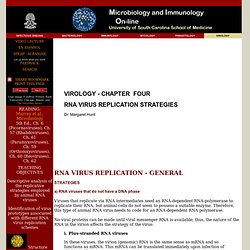
X-ray data from Hogle et al. (Harvard Univ.), PDB entry 2PLV, rendered with GRASP (A.Nicholls, Columbia Univ.). Courtesy of Dr Sgro and the Institute for Molecular Virology, Univ. of Wisconsin (used with permission) a) RNA viruses that do not have a DNA phase Viruses that replicate via RNA intermediates need an RNA-dependent RNA-polymerase to replicate their RNA, but animal cells do not seem to possess a suitable enzyme. No viral proteins can be made until viral messenger RNA is available; thus, the nature of the RNA in the virion affects the strategy of the virus: i. Examples: poliovirus (picornavirus) togaviruses flaviviruses.
Herpesviruses. Human Immunodeficiency Virus model. This human immunodeficiency virus model summarizes the results from more than 100 of the latest scientific publications in the fields of virology, analysis and NMR spectroscopy. The depicted spatial configurations of 17 different viral and cellular proteins found in the HIV particle are in strict accordance with known 3D structures. The viral membrane in the model includes 160,000 lipid molecules of 8 different types in the proportion found in the HIV particle. ♥ Virology. HIV as you've never seen it before. Google Image Result for. Slideshow: What It’s Like to Live With HIV/AIDS: Myths and Facts. CMV Vaccine Clears SIV in Monkeys. Hillsboro, OR -- May 11, 2011 -- Research conducted at Oregon Health and Science University's Vaccine and Gene Therapy Institute (VGTI) has developed a vaccine candidate in non-human primates that may eventually lead to a vaccine against Human Immunodeficiency Virus (HIV).
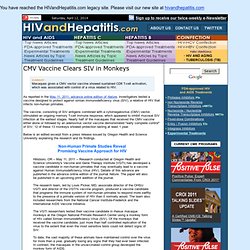
Details of this advance are published in the advance online edition of the journal Nature. The paper will also be published in an upcoming print addition of the journal. The research team, led by Louis Picker, MD, associate director of the OHSU VGTI and director of the VGTI's vaccine program, produced a vaccine candidate that programs the immune system of non-human primates to respond more swiftly to the presence of a primate version of HIV than it normally would.
The team also included researchers from the National Cancer Institute-Frederick and the International AIDS Vaccine Initiative. "The next step in vaccine development is to test the vaccine candidate in clinical trials in humans. HIV / AIDS Replication Animation Video. HIV (Human immunodeficiency virus) HIV. Immune System 101. How does your immune system work?

Your immune system works because your body is able to recognize "self" and "non-self. " This means that your body is able to tell if an invader (virus, bacteria, parasite, or other another person's tissues) has entered it—even if you aren't consciously aware that anything has happened. Retrovirus Replication 3D Animation. Possible cure for HIV? (Viral Decay Acceleration) HIV LIFECYCLE. Unusual AIDS Vaccine Shows Promising Results in Monkeys. A new study gives a much-needed booster shot to the beleaguered AIDS vaccine field.
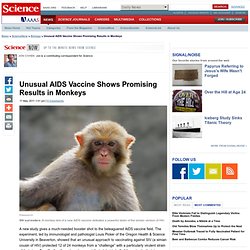
The experiment, led by immunologist and pathologist Louis Picker of the Oregon Health & Science University in Beaverton, showed that an unusual approach to vaccinating against SIV (a simian cousin of HIV) protected 12 of 24 monkeys from a “challenge” with a particularly virulent strain of that virus. Specifically, all monkeys became infected, but in half of the animals, their immune systems drove the virus down to undetectable levels for more than a year. “It’s the best result I’ve seen against the worst SIV known,” says the University of Wisconsin’s David Watkins, an immunologist who tests AIDS vaccines in monkeys and was not involved with the work. “I’m very excited by this approach.” The vaccine contains SIV genes stitched into cytomegalovirus (CMV), a herpesvirus that harmlessly infects many humans and serves as the delivery vehicle, or vector, for the AIDS virus proteins.
3D Video images of HIV transfer between T cells through virological synapses. Google Image Result for. HIV Life Cycle.mov. Human Immunodeficiency Virus Infection: Human Immunodeficiency Virus (HIV) Global Statistics. The lifecycle of cytomegalovirus. How Do You Get HIV or AIDS? Dr. Muralidhar Varma. Treatment of HIV. Lecture 12 Virology. Viruses, Viroids, and Prions I.
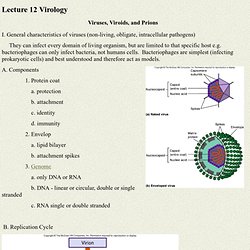
General characteristics of viruses (non-living, obligate, intracellular pathogens) They can infect every domain of living organism, but are limited to that specific host e.g. bacteriophages can only infect bacteria, not humans cells. Bacteriophages are simplest (infecting prokaryotic cells) and best understood and therefore act as models. A. 1. A. protection.